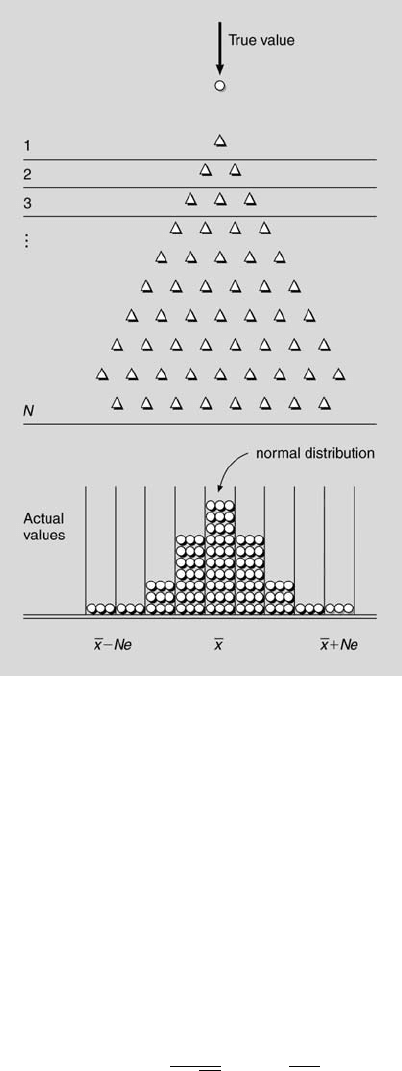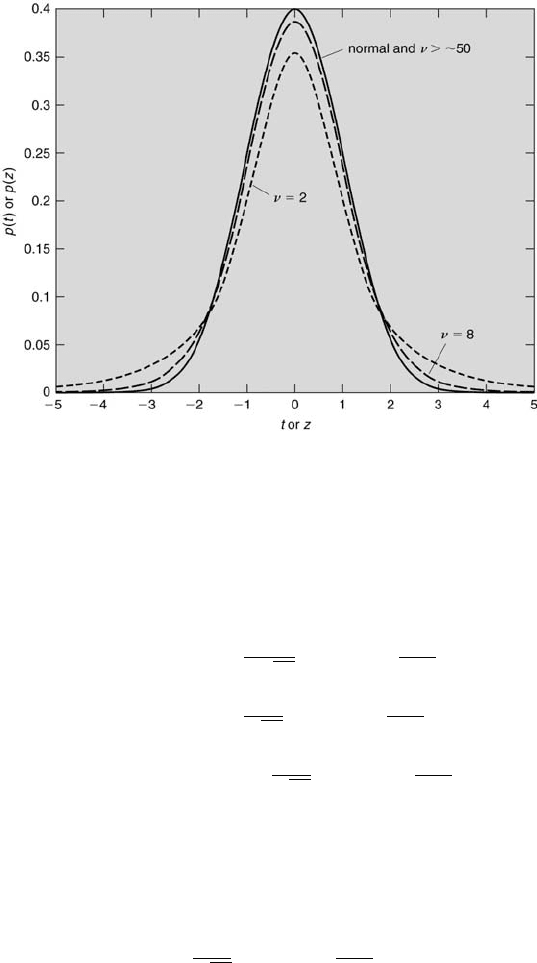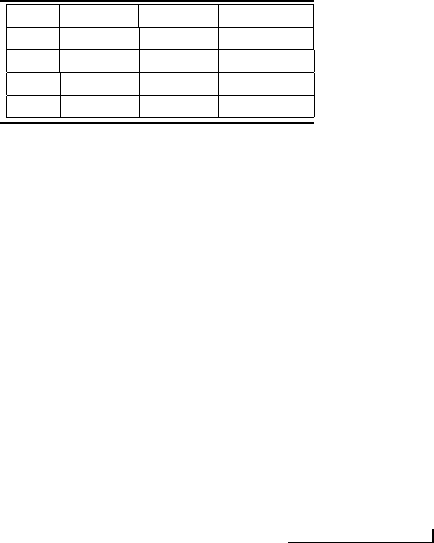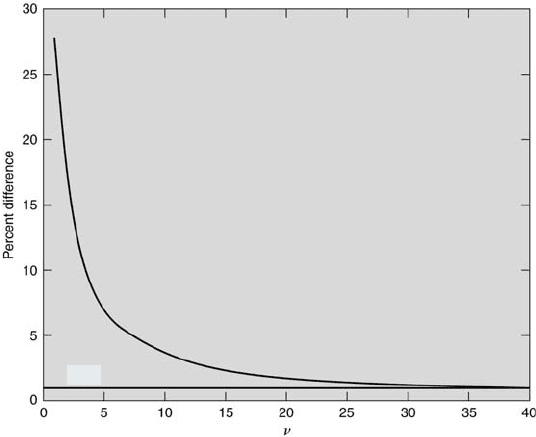Patrick F. Dunn, Measurement, Data Analysis, and Sensor Fundamentals for Engineering and Science, 2nd Edition
Подождите немного. Документ загружается.


186 Measurement and Data Analysis for Engineering and Science
measurement subject to many small random errors will be distributed nor-
mally. Further, the mean values of finite samples drawn from a distribution
other than normal will most likely be distributed normally, as assured by
the central limit theorem.
Francis Galton (1822-1911) devised a mechanical system called a quin-
cunx to demonstrate how the normal probability density function results
from a very large number of small effects with each effect having the same
probability of success or failure. This is illustrated in Figure 6.2. As a ball
enters the quincunx and encounters the first effect, it falls a lateral distance
e to either the right or the left. This event has caused it to depart slightly
from its true center. After it encounters the second event, it can either re-
turn to the center or depart a distance of 2e from it. This process continues
for a very large number, N, of events, resulting in a continuum of possible
outcomes ranging from a value of ¯x − Ne to a value of ¯x + N e. The key,
of course, to arrive at such a continuum of normally distributed values is
to have e small and N large. This illustrates why many phenomena are
normally distributed. In many situations there are a number of very small,
uncontrollable effects always present that lead to this distribution.
6.3 Normalized Variables
For convenience in performing statistical calculations, the statistical variable
often is nondimensionalized. For any statistical variable x, its standardized
normal variate, β, is defined by
β = (x − x
0
)/σ, (6.3)
in which x
0
is the mean value of the population and σ its standard devia-
tion. In essence, the dimensionless variable β signifies how many standard
deviations that x is from its mean value. When a specific value of x, say x
1
,
is considered, the standardized normal variate is called the normalized z
variable, z
1
, as defined by
z
1
= (x
1
− x
0
)/σ. (6.4)
These definitions can be incorporated into the probability expression of a
dimensional variable to yield the corresponding expression in terms of the
nondimensional variable. The probability that the dimensional variable x
will be in the interval x
0
± δx can be written as
P (x
0
− δx ≤ x ≤ x
0
+ δx) =
Z
x
0
+δx
x
0
−δx
p(x)dx. (6.5)

Statistics 187
FIGURE 6.2
Galton’s quincunx.
Note that the width of the interval is 2δx, which in some previous expressions
was written as ∆x. Likewise,
P (−x
1
≤ x ≤ +x
1
) =
Z
+x
1
−x
1
p(x)dx. (6.6)
This general expression can be written specifically for a normally dis-
tributed variable as
P (−x
1
≤ x ≤ +x
1
) =
Z
+x
1
−x
1
1
σ
√
2π
exp
−
1
2σ
2
(x − x
0
)
2
dx. (6.7)

188 Measurement and Data Analysis for Engineering and Science
FIGURE 6.3
The normal and Student’s t probability density functions.
Using Equations 6.3 and 6.4 and noting that dx = σdβ, Equation 6.7 be-
comes
P (−z
1
≤ β ≤ +z
1
) =
1
σ
√
2π
Z
+z
1
−z
1
exp
−β
2
2
σdβ,
=
1
√
2π
Z
+z
1
−z
1
exp
−β
2
2
dβ,
= 2
1
√
2π
Z
+z
1
0
exp
−β
2
2
dβ
. (6.8)
The factor of 2 in the last equation reflects the symmetry of the normal
probability density function, which is shown in Figure 6.3, in which p(z)
is plotted as a function of the normalized-z variable. The term in the { }
brackets is called the normal error function, denoted as p(z
1
). That is
p(z
1
) =
1
√
2π
Z
+z
1
0
exp
−β
2
2
dβ. (6.9)
The values of p(z
1
) are presented in Table 6.2 for various values of z
1
. For
example, there is a 34.13 % probability that a normally distributed variable
z
1
will be within the range from x
1
−x
0
= 0 to x
1
−x
0
= σ [p(z
1
) = 0.3413].
In other words, there is a 34.13 % probability that a normally distributed

Statistics 189
z
P
% P
1
68.27
1.645
90.00
1.960
95.00
2
95.45
2.576
99.00
3
99.73
4
99.99
TABLE 6.1
Probabilities of some common z
P
values.
variable will be within one standard deviation above the mean. Note that the
normal error function is one-sided because it represents the integral from 0
to +z
1
. Some normal error function tables are two-sided and represent the
integral from −z
1
to +z
1
. Always check to see whether such tables are either
one-sided or two-sided.
Using the definition of z
1
, the probability that a normally distributed
variable, x
1
, will have a value within the range x
0
± z
1
σ is
2p(z
1
) =
2
√
2π
Z
+z
1
0
exp
−
β
2
2
dβ =
% P
100
. (6.10)
In other words, there is P percent probability that the normally distributed
variable, x
i
, will be within ±z
P
standard deviations of the mean. This can
be expressed formally as
x
i
= x
0
± z
P
σ (% P ). (6.11)
The percent probabilities for the z
P
values from 1 to 4 are presented in
Table 6.1. As shown in the table, there is a 68.27 % chance that a normally
distributed variable will be within ± one standard deviation of the mean
and a 99.73 % chance that it will be within ± three standard deviations of
the mean.
Example Problem 6.1
Statement: Consider the situation in which a large number of voltage measurements
are made. From this data, the mean value of the voltage is 8.5 V and that its variance
is 2.25 V
2
. Determine the probability that a single voltage measurement will fall in the
interval between 10 V and 11.5 V. That is, determine Pr[10.0 ≤ x ≤ 11.5].
Solution: Using the definition of the probability distribution function, P r[10.0 ≤
x ≤ 11.5] = P r[8.5 ≤ x ≤ 11.5] − P r[8.5 ≤ x ≤ 10.0]. The two probabilities on the
right side of this equation are found by determining their corresponding normalized
z-variable values and then using Table 6.2.
First, P r[8.5 ≤ x ≤ 10.0]:
z =
x − x
0
σ
=
10 − 8.5
1.5
= 1 ⇒ P (8.5 ≤ x ≤ 10.0) =
.6827
2
= 0.3413.

190 Measurement and Data Analysis for Engineering and Science
Then, P r[8.5 ≤ x ≤ 11.5]:
z =
11.5 − 8.5
1.5
= 2 ⇒ P (8.5 ≤ x ≤ 11.5) =
.9545
2
= 0.4772.
Thus, P r[10.0 ≤ x ≤ 11.5] = 0.4772 - 0.3413 = 0.1359 or 13.59 %. Likewise, the
probability that a single voltage measurement will fall in the interval between 10 V
and 13 V is 15.74 %.
Example Problem 6.2
Problem Statement: Based upon a large data base, the State Highway Patrol has
determined that the average speed of Friday-afternoon drivers on an interstate is 67
mph with a standard deviation of 4 mph. How many drivers out of 1000 travelling on
that interstate on Friday afternoon will be travelling in excess of 72 mph?
Problem Solution: Assume that the speeds of the drivers follow a normal distribu-
tion. The 72 mph speed first converted into its corresponding z-variable value is
z =
72 − 67
4
= 1.2. (6.12)
Thus, we need to determine
P r[z > 1.2] = 1 − P r[z ≤ 1.2] = 1 − (P r[−∞ ≤ z ≤ 0] + P r[0 ≤ z ≤ 1.2]). (6.13)
From the one-sided z-variable probability table
P r[0 ≤ z ≤ 1.2] = 0.3849. (6.14)
Also, because the normal probability distribution is symmetric about its mean
P r[−∞ ≤ z ≤ 0] = 0.5000. (6.15)
Thus,
P r[z > 1.2] = 1 − (0.5000 + 0.3849) = 0.1151. (6.16)
This means that approximately 115 of the 1000 drivers will be travelling in excess of
72 mph on that Friday afternoon.
6.4 Student’s t Distribution
It was about 100 years ago that William Gosset, a statistician working for
the Guinness brewery, recognized a problem in using the normal distribu-
tion to describe the distribution of a small sample. As a consequence of his
observations it was recognized that the normal probability density function
overestimated the probabilities of the small-sample members near its mean
and underestimated the probabilities far away from its mean. Using his data
as a guide and working with the ratios of sample estimates, Gosset was able
to develop a new distribution that better described how the members of
a small sample drawn from a normal population were actually distributed.

Statistics 191
z
P
0.00 0.01 0.02 0.03 0.04 0.05 0.06 0.07 0.08 0.09
0.0 .0000 .0040 .0080 .0120 .0160 .0199 .0239 .0279 .0319 .0359
0.1 .0398 .0438 .0478 .0517 .0557 .0596 .0636 .0675 .0714 .0753
0.2 .0793 .0832 .0871 .0910 .0948 .0987 .1026 .1064 .1103 .1141
0.3 .1179 .1217 .1255 .1293 .1331 .1368 .1406 .1443 .1480 .1517
0.4 .1554 .1591 .1628 .1664 .1700 .1736 .1772 .1808 .1844 .1879
0.5 .1915 .1950 .1985 .2019 .2054 .2088 .2123 .2157 .2190 .2224
0.6 .2257 .2291 .2324 .2357 .2389 .2422 .2454 .2486 .2517 .2549
0.7 .2580 .2611 .2642 .2673 .2704 .2734 .2764 .2794 .2823 .2852
0.8 .2881 .2910 .2939 .2967 .2995 .3023 .3051 .3078 .3106 .3133
0.9 .3159 .3186 .3212 .3238 .3264 .3289 .3315 .3340 .3365 .3389
1.0 .3413 .3438 .3461 .3485 .3508 .3531 .3554 .3577 .3599 .3621
1.1 .3643 .3665 .3686 .3708 .3729 .3749 .3770 .3790 .3810 .3830
1.2 .3849 .3869 .3888 .3907 .3925 .3944 .3962 .3980 .3997 .4015
1.3 .4032 .4049 .4066 .4082 .4099 .4115 .4131 .4147 .4162 .4177
1.4 .4192 .4207 .4222 .4236 .4251 .4265 .4279 .4292 .4306 .4319
1.5 .4332 .4345 .4357 .4370 .4382 .4394 .4406 .4418 .4429 .4441
1.6 .4452 .4463 .4474 .4484 .4495 .4505 .4515 .4525 .4535 .4545
1.7 .4554 .4564 .4573 .4582 .4591 .4599 .4608 .4616 .4625 .4633
1.8 .4641 .4649 .4656 .4664 .4671 .4678 .4686 .4693 .4699 .4706
1.9 .4713 .4719 .4726 .4732 .4738 .4744 .4750 .4758 .4761 .4767
2.0 .4772 .4778 .4783 .4788 .4793 .4799 .4803 .4808 .4812 .4817
2.1 .4821 .4826 .4830 .4834 .4838 .4842 .4846 .4850 .4854 .4857
2.2 .4861 .4864 .4868 .4871 .4875 .4878 .4881 .4884 .4887 .4890
2.3 .4893 .4896 .4898 .4901 .4904 .4906 .4909 .4911 .4913 .4916
2.4 .4918 .4920 .4922 .4925 .4927 .4929 .4931 .4932 .4934 .4936
2.5 .4938 .4940 .4941 .4943 .4945 .4946 .4948 .4949 .4951 .4952
2.6 .4953 .4955 .4956 .4957 .4959 .4960 .4961 .4962 .4963 .4964
2.7 .4965 .4966 .4967 .4968 .4969 .4970 .4971 .4972 .4973 .4974
2.8 .4974 .4975 .4976 .4977 .4977 .4978 .4979 .4979 .4980 .4981
2.9 .4981 .4982 .4982 .4983 .4984 .4984 .4985 .4985 .4986 .4986
3.0 .4987 .4987 .4987 .4988 .4988 .4988 .4989 .4989 .4989 .4990
3.5 .4998 .4998 .4998 .4998 .4998 .4998 .4998 .4998 .4998 .4998
4.0 .5000 .5000 .5000 .5000 .5000 .5000 .5000 .5000 .5000 .5000
TABLE 6.2
Values of the normal error function.

192 Measurement and Data Analysis for Engineering and Science
Because his employer would not allow him to publish his findings, he pub-
lished them under the pseudonym “Student”[2]. His distribution was named
the Student’s t distribution. “Student” continued to publish significant
works for over 30 years. Mr. Gosset did so well at Guinness that he eventu-
ally was put in charge of its entire Greater London operations [1].
The essence of what Gosset found is illustrated in Figure 6.3. The solid
curve indicates the normal probability density function values for various z.
It also represents the Student’s t probability density function for various t
and a large sample size (N > 100). The dashed curve shows the Student’s
t probability density function values for various t for a sample consisting
of 9 members (ν = 8), and the dotted curve for a sample of 3 members
(ν = 2). It is clear that as the sample size becomes smaller, the normal
probability density function near its mean (where z = 0) overestimates the
sample probabilities and, near its extremes (where z > ∼ 2 and z < ∼ −2),
underestimates the sample probabilities. These differences can be quantified
easily using the expressions for the probability density functions.
The probability density function of Student’s t distribution is
p(t, ν) =
Γ[(ν + 1)/2]
√
πνΓ(ν/2)
1 +
t
2
ν
−(ν+1)/2
, (6.17)
where ν denotes the degrees of freedom and Γ is the gamma function, which
has these properties:
Γ(n) = (n − 1)! for n = whole integer
Γ(m) = (m − 1)(m − 2)...(3/2)(1/2)
√
π for m = half −integer
Γ(1/2) =
√
π
Note in particular that p = p(t, ν) and, consequently, that there are an
infinite number of Student’s t probability density functions, one for each
value of ν. This was suggested already in Figure 6.3 in which there were
different curves for each value of N.
The statistical concept of degrees of freedom was introduced by R.A.
Fisher in 1924 [1]. The number of degrees of freedom, ν, at any stage in
a statistical calculation equals the number of recorded data, N, minus the
number of different, independent restrictions (constraints), c, used for the
required calculations. That is, ν = N − c. For example, when computing
the sample mean, there are no constraints (c = 0). This is because only the
actual sample values are required (hence, no constraints) to determine the
sample mean. So for this case, ν = N. However, when either the sample
standard deviation or the sample variance is computed, the value of the
sample mean value is required (one constraint). Hence, for this case, ν =
N − 1. Because both the sample mean and sample variance are contained
implicitly in t in Equation 6.17, ν = N −1. Usually, whenever a probability
density function expression is used, values of the mean and the variance are
required. Thus, ν = N −1 for these types of statistical calculations.

Statistics 193
The expressions for the mean and standard deviation were developed in
Chapter 5 for a continuous random variable. Analogous expressions can
be developed for a discrete random variable. When N is very large,
x
0
= lim
N→∞
1
N
N
X
i=1
x
i
(6.18)
and
σ
2
= lim
N→∞
1
N
N
X
i=1
(x
i
− x
0
)
2
. (6.19)
When N is small,
¯x =
1
N
N
X
i=1
x
i
(6.20)
and
S
2
x
=
1
N − 1
N
X
i=1
(x
i
− ¯x)
2
. (6.21)
Here ¯x denotes the sample mean, whose value can (and usually does) vary
from that of the true mean, x
0
. Likewise, S
2
x
denotes the sample variance
in contrast to the true variance σ
2
. The factor N − 1 occurs in Equation
6.21 as opposed to N to account for loosing one degree of freedom (¯x is
needed to calculate S
2
x
).
Example Problem 6.3
Statement: Consider an experiment in which a finite sample of 19 values of a
pressure are recorded. These are in units of kPa: 4.97, 4.92, 4.93, 5.00, 4.98, 4.92, 4.91,
5.06, 5.01, 4.98, 4.97, 5.02, 4.92, 4.94, 4.98, 4.99, 4.92, 5.04, and 5.00. Estimate the
range of pressure within which another pressure measurement would be at P = 95 %
given the recorded values.
Solution: From this data, using the equations for the sample mean and the sample
variance for small N,
¯p =
1
19
19
X
i=1
p
i
= 4.97 and S
p
=
v
u
u
t
1
19 − 1
19
X
i=1
(p
i
− ¯p)
2
= 0.046.
Now ν = N − 1 = 18, which gives t
ν,P
= t
18,95
= 2.101 using Table 6.4. So,
p
i
= ¯p ± t
ν,P
S
p
(% P ) ⇒ p
i
= 4.97 ± 0.10 (95 %)
.
Thus, the next pressure measurement is estimated to be within the range of 4.87 kPa
to 5.07 kPa at 95 % confidence.
Now, what if the sample had the same mean and standard deviation values but
they were determined from only five measurements? Then
t
ν,P
= t
4,95
= 2.770 ⇒ p
i
= 4.97 ± 0.13 (95 %)

194 Measurement and Data Analysis for Engineering and Science
t
ν,P
%P
ν=2
%P
ν=8
%P
ν=100
1
57.74
65.34
68.03
2
81.65
91.95
95.18
3
90.45
98.29
99.66
4
94.28
99.61
99.99
TABLE 6.3
Probabilities for some typical t
ν,P
values.
.
For this case the next pressure measurement is estimated to be within the range of 4.84
kPa to 5.10 kPa at 95 % confidence. So, for the same confidence, a smaller sample size
implies a broader range of uncertainty.
Further, what if the original sample size was used but only 50 % confidence was
required in the estimate? Then
t
ν,P
= t
18,50
= 0.668 ⇒ p
i
= 4.97 ± 0.03 (50 %)
.
For this case the next pressure measurement is estimated to be within the range of 4.94
kPa to 5.00 kPa at 50 % confidence. Thus, for the same sample size but a lower required
confidence, the uncertainty range is narrower. On the contrary, if 100 % confidence was
required in the estimate, the range would have to extend over all possible values.
In a manner analogous to the method for the normalized z variable in
Equation 6.4, Student’s t variable is defined as
t
1
= (x
1
− ¯x)/S
x
. (6.22)
It follows that the normally distributed variable x
i
in a small sample will
be within ±t
ν,P
sample standard deviations from the sample mean with %
P confidence. This can be expressed formally as
x
i
= ¯x ± t
ν,P
S
x
(% P ). (6.23)
The interval ±t
ν,P
S
x
is called the precision interval. The percentage prob-
abilities for the t
ν,P
values of 1, 2, 3, and 4 for three different values of ν
are shown in Table 6.3. Thus, in a sample of nine (ν = N − 1 = 8), there
is a 65.34 % chance that a normally distributed variable will be within ±
one sample standard deviation from the sample mean and a 99.61 % chance
that it will be within ± four sample standard deviations from the sample
mean. Also, as the sample size becomes smaller, the percent P that a sam-
ple value will be within ± a certain number of sample standard deviations
becomes less. This is because Student’s t probability density function is
slightly broader than the normal probability density function and extends
out to larger values of t from the mean for smaller values of ν, as shown in
Figure 6.3.

Statistics 195
1 %
FIGURE 6.4
Comparison of Student’s t and normal probabilities.
Another way to compare the Student’s t distribution with the normal
distribution is to examine the percent difference in the areas underneath
their probability density functions for the same range of z and t values.
This implicitly compares their probabilities, which can be done for various
degrees of freedom. The results of such a comparison are shown in Figure
6.4. The probabilities are compared between t and z equal to 0 up to t
and z equal to 5. It can be seen that the percent difference decreases as the
number of degrees of freedom increases. At ν = 40, the difference is less than
1 %. That is, the areas under their probability density functions over the
specified range differ by less than 1 % when the number of measurements
are approximately greater than 40.
The values for t
ν,P
are given in Table 6.4. Using this table, for ν = 8
there is a 95 % probability that a sample value will be within ±2.306 sample
standard deviations of the sample mean. Likewise, for ν = 40, there is a 95
% probability that a sample value will be within ±2.021 sample standard
deviations of the sample mean.
A relationship between Student’s t variable and the normalized-z vari-
able can be found directly by equating the x
0
i
s of Equations 6.11 and 6.23.
